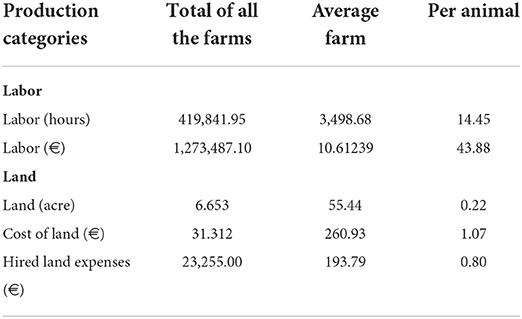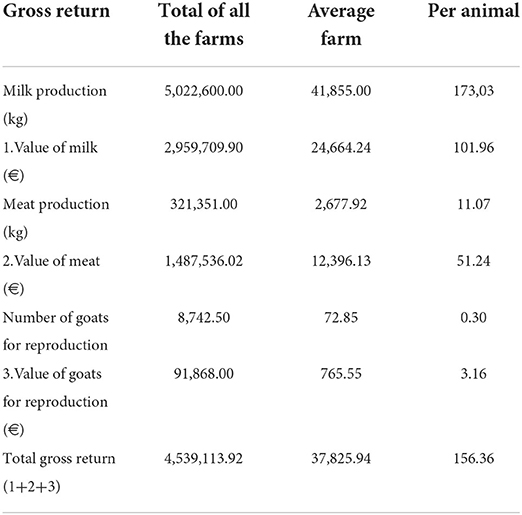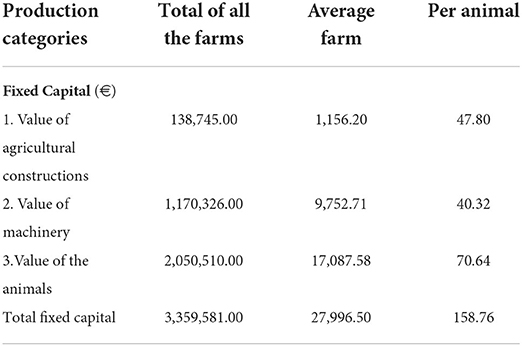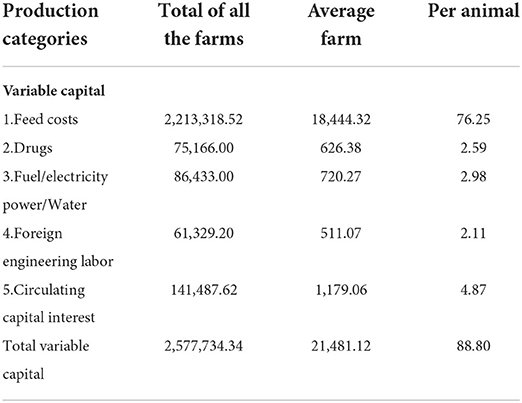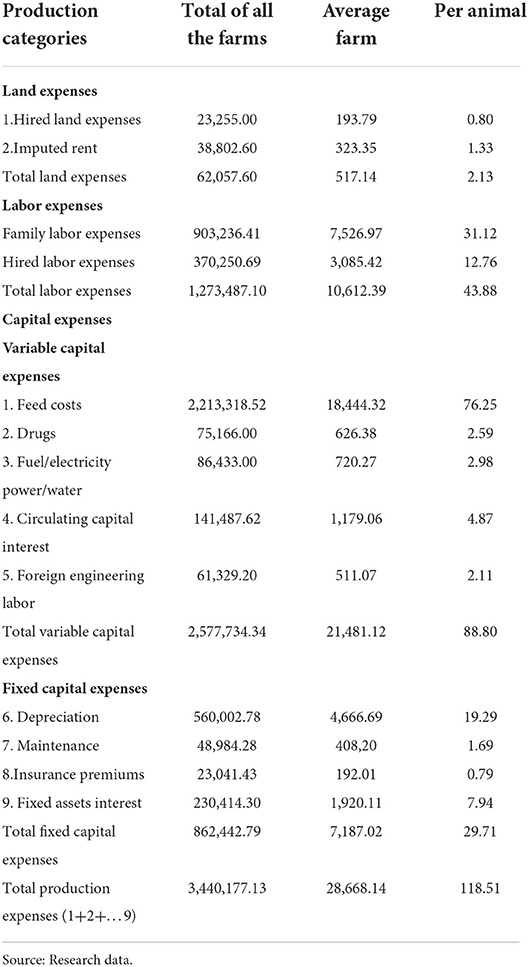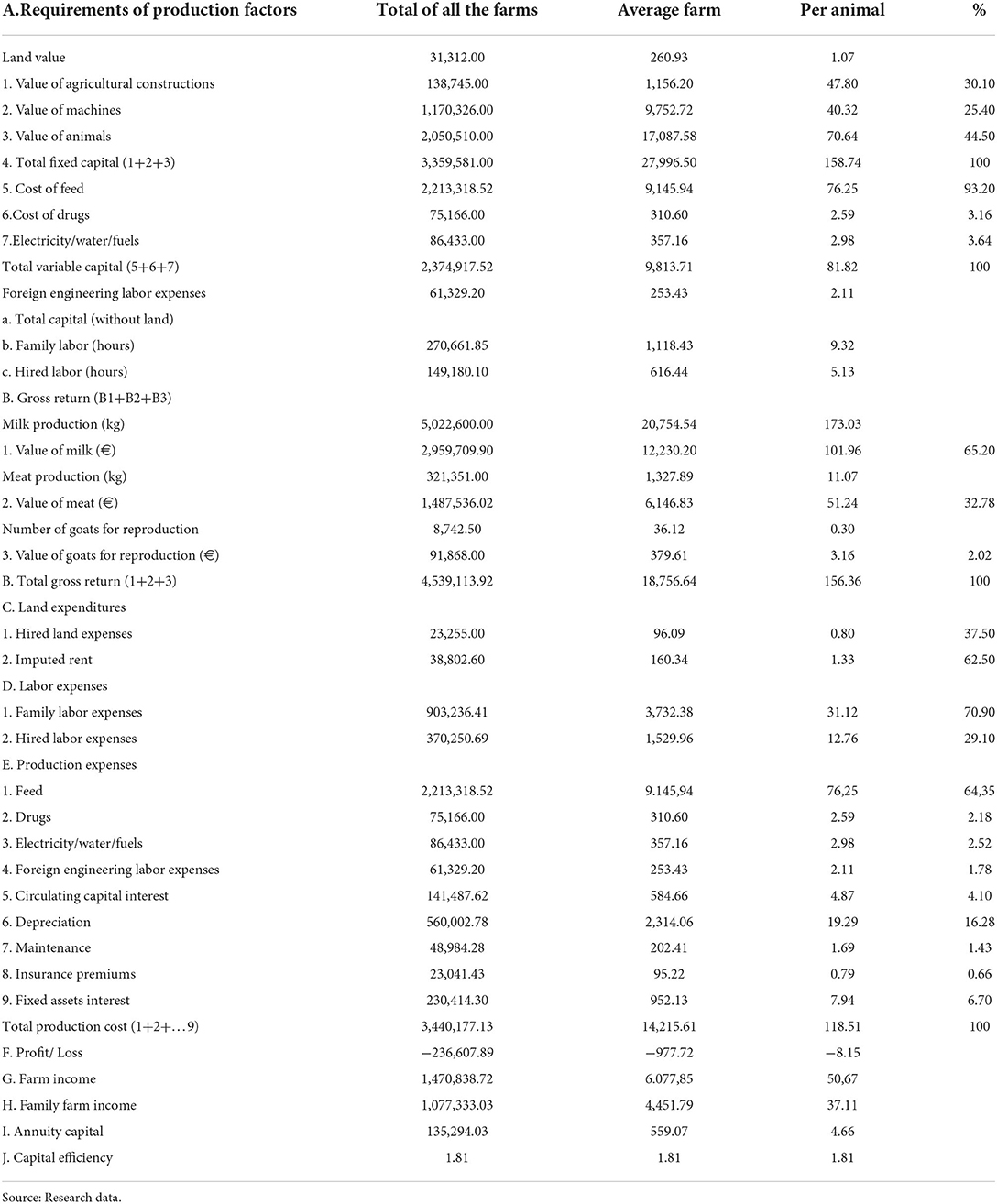Techno-economic and financial index analysis for the improvement of entrepreneurship and competitiveness strategies of Greek goat enterprises
- 1School of Agriculture, International Hellenic University, Thessaloniki, Greece
- 2Department of Animal Production, Faculty of Agriculture, Aristotle University of Thessaloniki, Thessaloniki, Greece
- 3School of Business Administration, International Hellenic University, Serres, Greece
Greece is a country with a long tradition in animal breeding, particularly involving small ruminants and goat farming is an important livestock industry. Despite the high productivity and high quality of products, the goat industry shows low competitiveness due to high production costs compared to other EU countries. For economic sustainability, farms have to be profitable; therefore, it is important to maximize income whilst controlling costs. The aim of this paper is to identify the strengths and weaknesses of the goat breeding industry so that it is not only viable but also competitive. The economic performance of goat farms are evaluated in this study, as well as the factors that influence financial results. Capital formation and production costs composition of the holdings are examined. Moreover, the purpose of the analysis is to draw conclusions regarding the gross return achieved, the participation of production factors (land, labor, capital) in the composition of total costs, and the financial results achieved. Results show that the cost of feed, depreciation, and the value of animals contribute most in the formulation of cost.
Introduction
Greece is a country with a long tradition in animal breeding, particularly involving small ruminants and goat farming is an important livestock industry. A large proportion of goat milk and meat production takes place in mountainous and disadvantaged areas in Greece, which are characterized by poor resources in comparison to other rural areas and remoteness from the main centers of population.
Greece holds the fourth position in world production of goat's milk while holding the second position among the EU countries, after France. The total number of goats in the country is around 4.8 million heads (FAO.ORG, 2019). According to FAO.ORG (2019), the number of milked adult female goats in Greece is 3,350,000.
Goat farming has a major financial impact, due to the production of large product quantities of a high biological and dietary value, the fact that it provides employment and an adequate stable income to a large number of animal breeders, and the creation of added value through the processing and trading of goat's meat and milk.
Although the goat sector produces high-quality products, it shows little competitiveness as a result of high production costs compared to other countries within the EU (Aggelopoulos et al., 2009; Vlontzos and Duquenne, 2009). This indicates that the industry has a low level of efficiency and competitiveness. The profitability of Greek goat farms is variable with many farms making a net loss. Around 75% of goat holdings in Greece are not viable, while about 10% are marginally viable (Arsenos, 2012).
Profitability is essential for economic sustainability; therefore, farms must maximize income while controlling costs. Goat farms rely heavily on meat and milk production for income, but little information is available on factors that explain differences in gross returns between farms (Lima et al., 2020). In order to remain economically viable over the long run, you need a regular stream of income to cover both fixed and variable costs (Lima et al., 2020). It is therefore critical to maximize income whilst controlling costs.
A number of researchers have studied the viability of the breeding sector, as well as the potential for further improving its competitiveness.
Zioganas et al. (2001), studied the technical and economic characteristics of sheep and goat farms with the calculation of returns, costs, profit, and income (with and without subsidies), and assigned them to geographic regions.
Aggelopoulos et al. (2009), stated that the most important problem of sheep farming is the high cost of production, which affects the competitiveness of the sector. This study investigates the restructuring and development possibilities of sheep farms in Greece, by reducing the production costs. The results showed that the production costs should be reduced by the appropriate use of capital, the rational use of feed, and the reduction of family labor.
Miliadou (2010), studied the economic characteristics of organic sheep and goat farms, taking into account the effect of farm size in the formulation of production costs, income, and returns.
Tzouramani et al. (2011), studied the viability of organic sheep farming. The economics of organic farms in relation to conventional sheep farming were also investigated. The results showed that in sheep farms, labor costs account for 20% of total costs, land costs 1.5%, variable capital costs 54%, fixed capital costs 25%, feed costs 48%, and interest, amortizations, maintenance, and insurance premiums 20%. Finally, the production costs amount to 188 €/animal.
Toro-Mujica et al. (2012), studied the zootechnical characteristics, and economic and social impact of organic sheep farming in south-central Spain. The results showed that the more intensive holdings had higher production costs. In this study, fixed capital expenditures accounts to € 49/animal, farm income to € 79/animal, and gross revenues accounts to € 17/animal, where 54% comes from milk and 26% from meat sales. Feed expenditure accounts for 37% of total expenditures, labor costs at 33% and depreciations at 12%.
Theocharopoulos et al. (2007), studied the factors that affect the production cost and determined the technical efficiency of the sheep farms. The results showed that the technical efficiency and the size of the livestock are important factors affecting the Greek sheep breeding. Moreover, in this study it was found that, feed costs accounts 34% of production costs, labor 33%, while fixed capital costs 86%. The sheep farms showed loss (-11.5 €/animal), the farm income without subsidies was 69 €/animal, the family income is 61 €/animal and finally, the gross return accounts to 85 €/animal.
Gökdai and Sakarya (2021), studied the factors affecting the profitability of Saanen goat enterprises in Turkey. The findings of the enterprises were determined by descriptive statistics, and multiple regression analysis was used to determine the factors affecting the total profitability of the enterprises. Results show that feed costs represented 46.22% of total production cost, it was followed by labor costs (27.19%), fuel costs (5.44%), and veterinarian-health service costs (5.19%). The main component of the sub-income factors across enterprises was the increase in inventory value with a ratio of 51.53%.
In another study about productive efficiency strategies in Spanish extensive sheep farms the results show that feeding costs account for 57% of the expenses. The general costs account for 24% of the expenses, followed by salaries, sanitary costs, and leasing costs (6%, respectively). The total average cost per ewe was 62 € (Daniele et al., 2021).
In a study that took place in Spain, labor was the largest cost (52%). Fixed costs (salaries, rents paid for leasing and amortization) accounted for 64.6% of the total cost and variable costs (feed, veterinary services, and other goods) accounted for 35.4% of the total cost (Díaz-Gaona et al., 2019).
Through the literature review, it is observed that issues related to the viability of sheep and goat farming have been studied thoroughly, however, there are no bibliographic reports that concern exclusively the goat sector. For this reason, the technic and economic study of goat farming and the calculation of the basic economic results is necessary.
The purpose of the technic and economic analysis is to identify the strengths and weaknesses of the goat breeding industry, so that it is not only viable but also competitive. The economic performance of goat farms iareevaluated in this study, as well as the factors that influence financial results. Capital formation and production costs composition of the holdings are examined. Moreover, the purpose of the above technical and economic analysis is to draw conclusions regarding the gross return achieved, the participation of production factors (land, labor, capital) in the composition of total costs and the financial results achieved.
Methodology
The technic and economic analysis was carried out based on the methodology developed in the context of economic livestock production (Papanagiotou, 2008). Data collection was performed through interviews and an on-site visit. At the start of the visit, farmers completed a face to- face questionnaire, including farm and management characteristics relating to a total of 118 different issues assessed (Siardos, 2009). The survey took place during 2019-2020.The farmers answered a set of open-ended and closed questions, included in a semi-structured questionnaire that lasted 1 h. In the questionnaire, there were questions about the farm's characteristics and management practices. This report included information about the farm size and structure, facilities and equipment, feed management, labor cost, fixed and variable capital, various expenses, production, and economic information.
The survey involved the Regional Unit of Thessaloniki, Northern Greece. The area is composed of a set of sub-areas with special geographical, and ecological characteristics, resulting in considerable inter-sectoral differences and equally rich variety in production, economic activities, and use of available resources. The analysis included the calculation of technical and economic indicators of farm performance, the presentation of the structure of farm expenses per production factor (land, labor, and capital) as well as the calculation of basic financial results. The sample included 120 goat farms with an average number of animals of 242 ± 65.68 per farm. The results have been calculated on the total holdings, on average holdings and per animal.
The statistical analysis of the survey questionnaires was performed using the SPSS 24 statistical package.
Results
Technical and economic analysis of the sample
Analysis of the organization of goat farms
Table 1 presents the labor (calculated in hours) that is used in the farms. Labor refers to the human labor that is available for milking, raising, as well as for production of animal feed. The working hours of the average holding of the sample that breeds 242 animals amount to 3,498.68 h. The labor per animal amounts to 14.45 h. The cost of labor of the average farm amounts to € 10,612.39, while per animal to € 43.88.
Table 2 presents the land organization in acres as well as its value. The average goat farm has 55.44 acres. The value of the privately-owned land amounts to € 260.93 in the average holding or € 1.07 per animal, while the value of the rented land amounts to € 193.79 in the average holding or € 0.80 per animal.
Table 3 presents the organization of fixed capital. The fixed capital cost of goat farms consists of the value of the buildings, machinery and animals. The average farm fixed capital amounts to € 27,996.50 or € 158.76 per animal. The value of agricultural constructions amounts to € 40.32 per animal and € 1,156.20 per holding, while the value of the machines amounts to € 9,752.71 per holding or € 40.32 per animal. The value of the animals amounts to € 17,087.58 per holding or € 70.64 per animal.
Table 4 presents the organization of variable capital. The variable capital is composed of animal feed, medicines, fuels, electricity, water, foreign engineering labor and circulating capital interest. In the average farm the variable capital amounts to € 21,481.12 or € 88.80 per animal. The cost of the feed amounts to € 18,444.32 per holding and € 76.25 per animal. The drugs amount to € 2.59 per animal, the cost of fuels, electricity and water amounts to € 2.98 per animal. Foreign engineering labor amounts to € 511.07 per holding and € 2.11 per animal. Finally, the circulating capital interest amounts to € 1,179.06 per holding and € 4.87 per animal.
Table 5 presents the production costs. Land costs amount to € 517.14 per holding and € 2.13 per animal. Labor costs amount to € 10,612.39 per holding and € 43.88 per animal, of which € 31.12 per animal come from family labor and € 12.76 per animal from foreign labor. Variable capital expenditures amount to € 21,481.12 per holding and € 88.80 per animal, while fixed capital expenditures amount to € 7,187.02 per holding and € 29.71 per animal.
Table 6 presents the composition of the gross return of the farms. Gross return consists of the value of milk and meat, as well as the sale of goats for breeding. The average yield in milk amounts to 173.03 kg/animal, while the value of milk amounts to 101.96 €/animal. The average price of milk is € 0.58. The average yield in meat is 11.07 kg/animal, while the value of meat is € 51.24/animal. The average selling price of meat is € 4.6. The value of goats given for breeding amounts to € 3.16/animal, while the average number of goats given for breeding is about 73 animals per goat farm. The total gross return per animal amounts to € 156.36.
The average size of a goat farm is 242 animals. The annual labor amount to 14.45 h per animal, of which 9.3 h/animal are covered by family participation and 5.1 h/animal are covered by foreign labor. Therefore, it is concluded that goat breeding is an industry where only family labor is not enough in order to cover all the needs.
Capital requirements amount to € 247.54/animal, of which 66% (€ 159/animal) represents fixed and only 34% (€ 82/animal) variable capital. The most important factor in the formation of fixed capital is the value of animals with € 70.6/animal, i.e., 44.5% of the total fixed capital. They are followed by the value of constructions with € 47.8/animal (30.1%) and the machines with € 40.3/animal (25.4%). The value of the consumable capital exceeds € 81/animal, with the main components of the diet amounting to € 76.2/animal, i.e., ~93% of the total consumables.
Gross return, in the average goat farm, comes at 65% from milk sale, 33% from the sale of meat and 2% from the sale of lambs for reproduction. The gross return amounts to € 156.3/animal, without the subsidy.
The total production costs of the average goat farm amount to € 118.5/animal, where labor amounts to 27% of the total production costs of the average farm, variable capital costs represent 54% of the total production costs, feed costs participate with 46% of total production costs and finally, fixed capital expenditures constitute 18% of total production costs.
From the other expenses, depreciations contribute to the formation of the production expenses, with € 19.29/per animal and a percentage of 16.3%. Moreover, the interest of the fixed capital amounts to 7.9 4 €/animal and a percentage of 6.7%.
The average goat farm shows a loss of €−8.15 animal, not including subsidies, while the farm income which is particularly important because it influences the living standard of goat farmers is estimated at € 50.67/animal. The farm's family income amounts to € 37.11/per animal. The return on capital amounts to € 4.66/animal, while the return on capital is estimated at 1.81%.
Discussion and conclusion
Goat farming is unsustainable without subsidies. Capital requirements amount to € 247.54/animal, of which 66% represents fixed and 34% variable capital. The average farm uses variable capital that amounts to € 88.80 per animal, while the fixed capital amounts to € 158.74 per animal. Regarding the variable capital, the value of the feed amounts to € 9,145.94 per holding and € 76.25 per animal. The drugs amount to € 2.59 per animal, and the fuel/PPC/water to € 2.98 per animal. Foreign mechanical work amounts to € 253.43 per holding and € 2.11 per animal. Finally, the working capital interest amounts to € 10,651.79 per holding and € 4.87 per animal.
The most important factor in the formulation of fixed capital is the value of animals which amounts to € 8,473.18 per holding or € 70.64 per animal, participating by 44.5% in the total fixed capital. The value of agricultural constructions amounts to € 40.32 per animal and € 4,836.06 per holding with approximately 30% participation in the formation of fixed capital. The value of the machines amounts to € 4,836.06 per holding or € 40.32 per animal with ~25% participation. In terms of expendable capital, food amounts to about 93% of the total. Production costs on a goat farm consist of land costs, labor costs and fixed and variable capital costs. Land costs amount to € 254.43 per holding and € 2.13 per animal. Labor costs amount to € 5,262.34 per holding and € 43.88 per animal, of which € 31.12 per animal comes from family work and € 12.76 per animal from foreign work. Variable capital expenditures amount to € 10,651.79 per holding and € 88.80 per animal, while fixed capital expenditures amount to € 3,563.82 per holding and € 29.71 per animal.
Variable capital expenditures represent 54% of the total production costs, while food expenditures account for 46% of the total production costs. Fixed capital expenditures account for 18% of total production costs, while labor accounts for 27% of the average production costs of the average farm. Of the other expenses, amortizations contribute to the formation of the production expenses, with a percentage of 16%. Moreover, the interest of the fixed capital participates with a percentage of about 7%.
Gross return, consists of the value of milk and meat, as well as the sales of goats for reproduction. The average yield in milk amounts to 173.03 kg/animal, while the value of milk amounts to € 101.96/animal. The average price of milk is € 0.58. The average yield in meat is 11.07 kg/animal, while the value of meat is € 51.24/animal. The average trading price of meat is € 4.6. The value of goats given for reproduction amounts to € 3.16/animal, while the average number of goats given for breeding amounts to ~36 per goat farm. The total gross income per goat amounts to € 156.36.
In average goat farming, 65% of the gross return comes from milk sales, 33% from meat sales, and 2% from the sale of goats for reproduction.
Concluding, the technical-economical analysis as a competitiveness measure of the Greek goat sector, one of the most important for the Greek Agricultural Economy sectors, and studying its economic results, important points of discussion and further study emerge to stimulate its competitiveness and ensure its viability.
In spite of the fact that most goat farms are family-run and small, family work cannot meet their needs, which highlights the chronic structural difficulties of Greek livestock and the need to deal with them by restructuring their size and converting them into a business (Galanopoulos et al., 2011). In addition its current form, subsidies are crucial to the competitiveness and viability of goat farms without which they appear unprofitable, which applies both to conventional as well as organic farms (Tzouramani et al., 2011; Tsiouni et al., 2021). The same situation exists not only in Greek goat farming but also in the goat farming of neighboring Balkan countries such as Bulgaria (Stankov, 2020).
As regards the production costs, and in particular food expenses, they are a key factor in determining the final economic result for the sector and its competitiveness. However, controlling and clearly identifying requires a high level of organization and developing strategies to boost competitiveness, such as establishing a system of quality assurance of products produced, a clear geographical identification of product origin, and the conditions for breeding and production, not only in Greece but in other Mediterranean countries (Papadopoulou et al., 2020; Daniele et al., 2021).
Based on the above results, both the importance of the goat farming sector and its weaknesses, as well as the opportunities and prospects it presents, become apparent. State and policymakers should give special attention to such topics as the establishment of an institutional framework to ensure the production and quality of goat products as well as the creation of distribution channels of those products as actions to support the goat farming sector and stimulate its extroversion and competitiveness. The existence of distribution channels between the producer and consumer is one of the topics of future research. The limitations of this research are the small number of farms and the limitation of the region, so the conclusions can't be generalized in the country. In the future, this research can be done all over the country or in EU countries in order to have comparative results.
Data availability statement
The original contributions presented in the study are included in the article/supplementary material, further inquiries can be directed to the corresponding author/s.
Ethics statement
Ethics review and approval/written informed consent was not required as per local legislation and institutional requirements.
Author contributions
TM: supervision and writing—original draft. GD: data curation. KC: methodology. AS: supervision. All authors contributed to the article and approved the submitted version.
Conflict of interest
The authors declare that the research was conducted in the absence of any commercial or financial relationships that could be construed as a potential conflict of interest.
The handling editor declared a past co-authorship with several of the authors TM, GD, and AS.
Publisher's note
All claims expressed in this article are solely those of the authors and do not necessarily represent those of their affiliated organizations, or those of the publisher, the editors and the reviewers. Any product that may be evaluated in this article, or claim that may be made by its manufacturer, is not guaranteed or endorsed by the publisher.
References
Aggelopoulos, S., Soutsas, K., Pavloudi, A., Sinapis, E., and Petkou, D. (2009). Suggestions for reformation in sheep farms based on production cost. J. Food Agricult. Environ. 7, 561–566.
Arsenos, G. (2012). “Goat farming, the emerging branch of Greek livestock farming: results from research program SOLID,” in Proceedings of the Workshop: The Contribution of goat farms to Rural Development of Greece: Problems and Prospects (Thessaloniki: GEOTEE).
Daniele, B., Barbara, S., Isabel, B., and Alberto, G. (2021). Economic risk assessment of the quality labels and productive efficiency strategies in Spanish extensive sheep farms. Agricult. Syst. 191:103169. doi: 10.1016/j.agsy.2021.103169
Díaz-Gaona, C., Sánchez-Rodríguez, M., Rucabado-Palomar, T., and Rodríguez-Estévez, V. (2019). A Typological Characterization of Organic Livestock Farms in the Natural Park Sierra de Grazalema Based on Technical and Economic Variables. Sustainability 11:6002. doi: 10.3390/su11216002
FAO.ORG (2019). FAOSTAT. Available online at: http://www.fao.org/faostat/en/ (accessed March 12, 2021).
Galanopoulos, K., Abas, Z., Laga, V., Hatziminaoglou, I., and Boyazoglu, J. (2011). The technical efficiency of transhumance sheep and goat farms and the effect of EU subsidies: Do small farms benefit more than large farms? Small Ruminant Res. 100, 1–7. doi: 10.1016/j.smallrumres.2011.05.008
Gökdai, A., and Sakarya, E. (2021). Determination of Goat Milk Cost and Assessment of Factors Affecting the Profitability of Saanen Goat Farms in Canakkale Province, Turkey. Ankara Üniversitesi Veteriner Fakültesi Dergisi. doi: 10.33988/auvfd.799114
Lima, M. V. S., Bagaldo, A. R., Muller, M., Pinheiro, E. G., Almeida, B. J., Mugab, L. C., et al. (2020). Intake, digestibility, ingestive behavior, production, and composition of goat milk supplemented with detoxified castor bean meal added urea as a replacement of soybean meal. Trop. Anim. Health Prod. 52, 2135–2143 doi: 10.1007/s11250-020-02240-7
Miliadou, D. (2010). Economic and Environmental Approach of the Organic Sheep and Goat Farming in Greece. PhD Dissertation, Aristotle University of Thessaloniki.
Papadopoulou, A., Ragkos, A., Theodoridis, A., Skordos, D., Parissi, Z., and Abraham, E. (2020). Evaluation of the contribution of pastures on the economic sustainability of small ruminant farms in a typical greek area. Agronomy 11:63. doi: 10.3390/agronomy11010063
Papanagiotou, E. (2008). Economic Production of Agricultural Products (3rd edition). Thessaloniki: Grafima Publications
Stankov, K. (2020). Economic results in the breeding of goats under intensive and extensive systems. Trakia J. Sci, 18, 250–255. doi: 10.15547/tjs.2020.03.011
Theocharopoulos, A., Melfou, K., and Papanagiotou, E. (2007). A microeconomic approach for agricultural development: A DEA application to Greek sheep farms. New Medit 6, 48–54.
Toro-Mujica, P., García, A., Gómez-Castro, A., Perea, J., Rodríguez-Estévez, V., Angón, E. A. N. D., et al. (2012). Organic dairy sheep farms in south-central Spain: Typologies according to livestock management and economic variables. Small Ruminant Res. 104, 28–36. doi: 10.1016/j.smallrumres.2011.11.005
Tsiouni, M., Aggelopoulos, S., Pavloudi, A., and Siggia, D. (2021). Economic and financial sustainability dependency on subsidies: the case of goat farms in Greece. Sustainability 13:7441. doi: 10.3390/su13137441
Tzouramani, I., Sintori, A., Liontakis, A., Karanikolas, P., and Alexopoulos, G. (2011). An assessment of the economic performance of organic dairy sheep farming in Greece. Livestock Sci. 141, 136–142. doi: 10.1016/j.livsci.2011.05.010
Vlontzos, G., and Duquenne, N. (2009). “Evolution of trade flows for sheep's milk cheese: an empirical model for Greece,” in: International Marketing and International Trade of Quality Food Products, eds M. Canavari, N. Cantore, A. Castellini, E. Pignatti, & R. Spadoni (Wageningen: Academic Publishers).
Keywords: techno-economic analysis, financial index analysis, goat enterprises, competitiveness strategies, Greece
Citation: Maria T, Dimitrios G, Christos K and Stamatis A (2022) Techno-economic and financial index analysis for the improvement of entrepreneurship and competitiveness strategies of Greek goat enterprises. Front. Sustain. Food Syst. 6:982307. doi: 10.3389/fsufs.2022.982307
Received: 30 June 2022; Accepted: 19 July 2022;
Published: 10 August 2022.
Edited by:
Dario Siggia, Universities and Research, ItalyReviewed by:
Edoardo Desiderio, Research Institutes of Sweden (RISE), SwedenStamatina Trivizaki, Ministry of Rural Development and Food, Greece
Copyright © 2022 Maria, Dimitrios, Christos and Stamatis. This is an open-access article distributed under the terms of the Creative Commons Attribution License (CC BY). The use, distribution or reproduction in other forums is permitted, provided the original author(s) and the copyright owner(s) are credited and that the original publication in this journal is cited, in accordance with accepted academic practice. No use, distribution or reproduction is permitted which does not comply with these terms.
*Correspondence: Tsiouni Maria, mtsiouni84@yahoo.gr
 Tsiouni Maria
Tsiouni Maria Gourdouvelis Dimitrios
Gourdouvelis Dimitrios Konstantinidis Christos
Konstantinidis Christos Aggelopoulos Stamatis1
Aggelopoulos Stamatis1